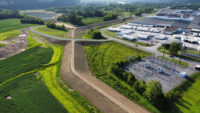Fire protection engineers are a valuable part of any building design and construction team. Although fire suppression system design is one of the FPE’s important responsibilities, the role of the FPE is much larger than just designing fire protection systems.
Society demands that the buildings it occupies not have a significant threat from fire. As a result, a significant portion of the cost of modern building construction is devoted to fire protection features. These features may include, but are not limited to: structural fire protection; suppression systems; egress systems; detection and emergency communication systems; and smoke management systems. The fire protection engineer assures that these systems all work together as a unified fire protection system that protects life, property, the environment and preserves continuity of operations.
In my previous May 2011 pme article “Know Their Roles” (available at www.pmengineer.com), I discussed the role fire protection engineers play in designing fire protection systems. This time, I’ll take a broader look at the role fire protection engineers play in designing buildings and will discuss some of the important factors that will impact fire protection design in the future: performance-based design; fire models; building information modeling; and how humans behave during fires.
The role of the FPE
Fire protection engineering is a unique profession that applies science and technology to make buildings safer from fire. Specifically, FPEs analyze how buildings are used, how fires start, how fires grow, and how fire and smoke affects people, buildings and property. Additionally, they use the latest technologies to design systems that control fires, alert people to danger and provide means for escape.
Specifically, fire protection engineers have the knowledge, training and experience in the following subject areas:
- Hazard and risk analysis;
- The principals of fire dynamics as related to fire and smoke behavior;
- Human response principles as related to safe evacuation movement;
- Active and passive fire protection system design; and
- Means of egress analysis.
Benefits of the FPE
As stated in the Society of Fire Protection Engineers position statement, having the guidance of a qualified and experienced FPE on the construction team early in the process can save time and expense in the design development, construction and post-construction phases of a project. The following are some benefits the FPE can add to the process:
- The FPE can coordinate the fire and life safety aspects of the design disciplines (architectural, structural, civil, mechanical and electrical).
- An FPE can help develop goals with an understanding that designs are intended to limit the threat to life safety for both the public and emergency responders and reduce potential property loss.
- An FPE can interpret a variety of applicable codes and standards with an understanding of how the building and its components function as an integrated fire and life-safety system.
- An FPE can focus specifically on scientific and engineering methods for fire and life-safety analysis and design.
- An FPE can produce a set of fire protection design documents that anticipate the details of a fire protection installation.
- If a problem is discovered during construction, the FPE can recommend corrective actions that can minimize change orders and associated cost increases.
- An FPE can develop a plan to commission and accept fire- and life-safety systems.
- Having a qualified and experienced FPE on the construction team can minimize the potential for conflicts from the outset of the project.
Performance-based design
Most fire protection requirements in buildings are designed based on “prescriptive” requirements. Prescriptive requirements that are established in the model codes and standards identify, in very specific terms, how fire protection is to be provided in buildings. The level of safety provided by prescriptive requirements is not precisely known, although history has shown that prescriptive requirements provide a reasonable level of safety.
However, because of their rigidity, prescriptive requirements can stifle innovation. Furthermore, as modern design and construction technologies advance in complexity, buildings are becoming taller and larger in area, and have more unusual shapes and unique uses. As a result, these complex designs may fall outside the scope of the prescriptive codes and standards.
With performance-based design, the FPE works with the building stakeholders to identify the level of safety that is to be provided without identifying exactly how it is to be accomplished. As such, performance-based design requires more engineering effort, although it results in more design flexibility.
Fire models
Since the early 1980s when the first computer- based fire models were developed, fire models have become an important tool in the FPE’s toolbox. These models are used to evaluate what could occur in the event of a fire. For example, fire models can estimate gas-layer temperatures, flame height, heat flux, heat release rate, ventilation, visibility, detector response and sprinkler response.
Fire models take on many different forms. The simplest fire models are algebraic equations that can be solved by using a basic scientific calculator. More complex fire models require the use of computers that utilize the principles of computational fluid dynamics to simulate the fire dynamics in a room enclosure.
But as SFPE’s “Substantiating a Fire Model for a Given Application” notes, “Increased sophistication does not always translate into better results.” At the same time, each model has its own limitations.
As such, it is the FPE’s responsibility to understand each model’s limitations and determine the correct model to use for the given application.
Building information modeling
Although relatively new to the FPE, building information modeling technology is a dynamic and powerful tool for use in all phases of a facility, and whose interest and acceptance is growing worldwide in the fire protection engineering community. To date, there has been limited interaction between the fire protection engineering community and the developers of BIM software.
Currently, third-party design programs that are compatible with the base design BIM software are being used to perform hydraulic calculations for sprinkler systems. Many of the major fire protection equipment manufacturers are now providing digital equipment data that can be incorporated in a BIM model.
As BIM tools continue to evolve, there is significant opportunity for the fire protection engineering community to become involved in the process and to influence how software/tools incorporate the fire protection engineering discipline. This includes fire suppression systems design, fire alarm and notification systems design, life safety and code compliance, and performance- based design.
How humans behave during fire
Discussions about providing the best form of fire protection engineering design for a building usually focus on active and passive fire protection systems. Although these systems play an essential role in protecting lives from fire, it is also important to note that FPEs also consider factors that may influence the behaviors of people during building emergencies.
Understanding how humans behave and predicting their responses during a fire emergency is an important part of any fire protection engineering design. At the same time, because of the many sociological aspects that are involved, it is difficult for FPEs to understand exactly how humans will respond during building emergencies.
Currently, there is a significant body of knowledge that addresses how humans behave when there is a fire in the building. Because the fire protection engineer understands these behaviors, he or she can use this knowledge to implement better fire protection engineering designs.


